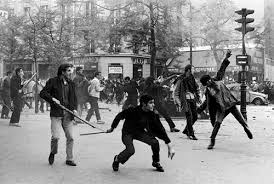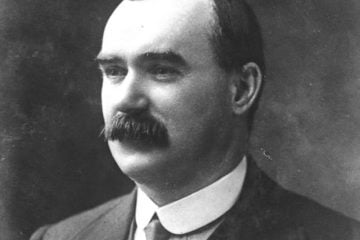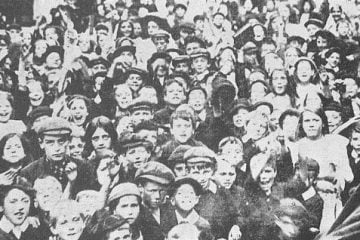January 3rd 1911 was the date that the full force of the British state was pitted against two Latvian anarchists, or former Latvarian Social Democrats to be precise, taking refuge in an East End property. The two Jewish radicals named Fritz Svaars and William Sokolow held their own for seven hours against 200 armed police, a detachment of Scots Guards from the Tower of London, and if the siege would have lasted any longer, a field artillery cannon (which had been commissioned by the then Home Secretary, Winston Churchill). The siege ended when a fire broke out inside the building which eventually killed the anarchists. Thousands of Londoners came out to view the battle, and it still resonates today as a reminder of an age where the British state sought to crush revolutionaries with guns and artillery.
The Seige of Sidney Street, or the “Battle of Stepney” was preceded by the Houndsditch murders. On 16th December 1910 a gang of Latvarian anarchists attempted to rob a jeweller’s shop at 119 Houndsditch. They had planned the robbery meticulously, renting a room behind the shop and buying a 60ft rubber hose to use gas from their building to burn through the safe. They had picked Friday for the robbery though, and in a predominantly Jewish area, the unexpected noise on the day of Sabbath had alerted residents, who proceeded to inform the police. The members of this gang were refugees from Latvia, where the 1905 revolution was put down with exceptional violence. Their experience would have told them that any uniformed officers were armed and ready to kill or torture anyone that fell into their hands. 9 unarmed officers arrived on the scene, 2 entered the building but were soon shot several times by the anarchists, and an officer who arrived to help was also shot in the street as they attempted to escape. These three officers died the next day, and two others were injured. One of the anarchists was injured too, but he also died later. The incident remains the single worst incident for British police during peacetime.
An intense search followed, and several of the gang members, associates, revolutionaries, and Latvarian anarchists were arrested in the following days. Authorities also offered a £500 reward for the capture of an unidentified woman, Svaars, and Peter “the Painter” Piatkov. As well as the official investigation, the murders sparked a severe social backlash against Eastern European people, particularly political refugees who lived in the East End, as they were lumped together with the anarchists as “foreign malefactors”. The Daily Mail newspaper ran a headline that read “Who are these fiends in human shape?” This is very unsurprising given the Daily Mail’s historic support of government authority and reactionary politics. On 15th January 1934 the paper even openly supported the fascist Oswald Mosley by publishing an article entitled “Hurrah for the Blackshirts!”
A fortnight after the shootings the police received information from a Mrs Gershon that two or three members of the gang, and possibly Peter the Painter, were hiding at 100 Sidney Street. The men inside, sensing they had been betrayed, seized the landlady and deprived her of her skirt and boots, assuming that no respectable Jewish woman would leave the house in her underclothes. But Mrs Gershon was made of sterner stuff, and slid out whilst the men were not watching.
Expecting heavy resistance, and not wanting anyone to escape, 200 armed police officers cordoned off the area after evacuating the other residents of the building, and on the morning of 3rd January 1911, the battle began.
The two anarchists were heavily outnumbered, but possessed far superior firepower and had great stores of ammunition (during the 7 hours, over 400 rounds had come from the house). The German Mauser automatic pistols proved to be far superior to the weaponary than the Metropolitan police had available, and so a detachment of Scots Guards armed with rifles were sent to help. The Liberal government’s Home Secretary Winston Churchill got word of the siege, and headed down to observe it himself. Dressed in his fur coat and top hat, he proceeded to give shooting advice to the police officers. A stray bullet even passed through his top hat. To add to his preposterous appearance, Churchill had commissioned a field artillery canon to shell the building, but the fire had broken out before he had a chance to use it. This move is nowhere near excessive for a man who has put tanks on the streets of Britain before. Once the fire brigade arrived, Churchill prevented them from putting out the fire until the firing had stopped, or in other words until the anarchists had been burnt alive. Sure enough no one emerged from the building, and the remains of 2 bodies were later found. A firefighter was also killed by falling debris from the destroyed building. Churchill’s role in this affair proved to be highly controversial. The man was known for his love of spectacle, and desire to be at the frontline of events. He even informed his secretary that the siege was “such fun!”
Nobody was ever convicted of killing the officers. One of the assailants arrested before the siege was Svaars’ cousin, Jacob Peters. No one knows who fired the fatal shots, but Donald Rumbelow, an ex-police officer, argued it was Peters. However unlike the others, Peters willingly allowed himself to be arrested, and put his faith in the British legal system. Peters was a member of the Bolshevik Party, not an anarchist, and the distinction is very significant. Given his membership of the disciplined Marxist organisation, it is incredibly unlikely for Peters to have been involved in such anarchist escapades. The initial counts of murder were less than dubious, and after 128 days Peters was acquitted by the court and returned to Russia, where after the 1917 revolution, he became a leading figure in Lenin’s secret police, the Cheka, but was eventually purged by Stalin in the 1930s.
Peter the Painter was never found, and there is little of evidence of him even being present at the siege. In recent years, a British author, Phil Ruff, has concluded that the most likely candidate for ‘Peter the Painter’ is Janis Zhaklis, a leading member of Latvia’s revolutionary Social Democratic movement who reportedly took part in armed attacks on the Tsarist regime’s prison and secret police department in Riga in 1905-6 before being forced into exile. Zhaklis’ commitment to armed struggle over political struggle apparently led him to split from the Social Democrats and move in a more anarchistic direction. In exile his political group, like others, raised funds for their struggle against autocratic oppressors through ‘expropriations’ – aka robbing the rich. The young Stalin was a noted bank robber for the Bolsheviks, arguably his most useful contribution to the revolutionary struggle. (Zhaklis is also said to have given Lenin some of the funds from an ‘expropriated’ Helsinki bank.) Before the abortive raid on the Houndsditch jewellers, Peter the Painter’s group of Latvians had staged another failed robbery in north London in January 1909, this time of a factory’s wages. The ‘Tottenham Outrage’ as it became known culminated in a six-mile armed police chase across the Lea Valley that left two dead and two dozen injured. Peter the Painter eventually became somewhat of a folk anti-hero in the East End and beyond. The Mauser C96 pistols he and the anarchists used were reportedly referred to as “Peter the Painters” in the Irish war of independence against the British Empire.
Over a hundred years on the blazing gun battle that was fought at 100 Sidney Street paints a picture of a bygone age of revolution and social and political radicalism, but also of the willingness of the British state to crush any form of revolutionary upsurge, even in a distorted anarchist form. The siege proved to be the impetus for the modernisation and militarisation of the British police force. There were also calls for tough new policies on immigration, and a general backlash against, and attempt to discredit, any kind of socialist politics. In today’s age of increasing police violence and increase in right-wing and reactionary politics, we can look to incidents like the Siege of Sidney Street to remind us what the true nature of the state apparatus is, an armed body of men in protection of private property and capitalism, willing to use whatever force it deems necessary to do so.
by Nigel Warren, Queen Mary Marxists



